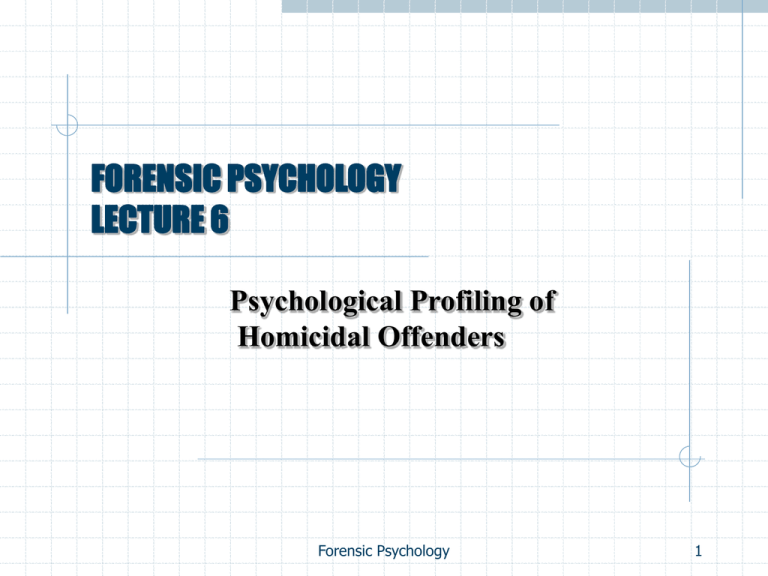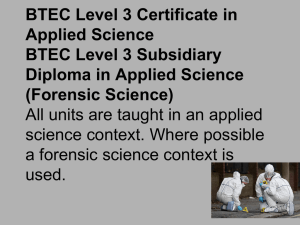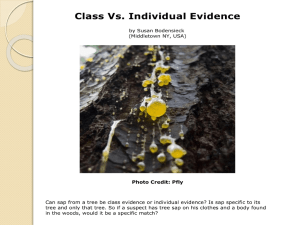
FORENSIC PSYCHOLOGY
LECTURE 6
Psychological Profiling of
Homicidal Offenders
Forensic Psychology
1
Recommended Reading
Schlesinger, L.B. (2000), Serial Offenders: Current Thought,
Recent Findings. Boca Raton, FL: CRC Press.
Brittain, R.P. (1970). The sadistic murderer. Medicine, Science and
Law. 10, 198-207.
Meloy, J.R. (2000). The nature and dynamics of sexual homicide.
Aggression and Violent Behaviour. 5, 1-22.
Prentky, R.A. et al. (1989). The presumptive role of fantasy in
serial sexual homicide. American Journal of Psychiatry. 146,
889-891.
Ressler, R.K., Burgess, A.W. and Douglas, J.E. (1986). Sexual
Killers and their victims: Identifying patterns through crime scene
analysis. Journal of Interpersonal Violence. 1, 288-308.
Forensic Psychology
2
Recommended Reading
Satten, J. et al. (1960). Murder without apparent motive.
American Journal of Psychiatry. 117, 48-53.
Schlesinger, L.B. (1996). The catathymic
crisis
(1912-present): a review and clinical study. Aggression and
Violent Behaviour. 1, 307-316.
Schlesinger, L.B. Murder and Sex Murder: Psychopathology
and Psychodynamics. Lethal Violence: A Sourcebook on Fatal,
Domestic, Acquaintance and Stranger Violence (Chapter 14)
Edited by Hall.
Warren, J.L, Hazelwood, R.R. and Dietz, P.E. (1996). The
sexually sadistic serial killer. Journal of Forensic Sciences. 41,
970-974.
Wertham, F. (1978). The catathymic crisis in LL. Ktash, S.B.
Ktash and L.B. Schlesinger (Eds.) Violence: Perspectives on
Murder and Aggression. San Francisco: Jossey-Bass.
Forensic Psychology
3
Learning Outcomes
Consider the role of the victim in homicide.
Explain the historical background to the study of
murder and describe the difficulties associated
with defining “serial homicide”.
Describe characteristics that are associated with
serial murderers.
Examine Motivational Models for Murder.
Forensic Psychology
4
Victimology
Study of Victims as a Science
Wolfgang (1958) – 588 murders in Philadelphia
94% of the same race
87% knew each other
82% male and less than 35
76% of victims were male
Stabbing most common method
66% of offenders has previous convictions
53/54% of offenders and victims were under the
influence of alcohol (Meloy, 2000)
Forensic Psychology
5
Classification of Murder
Various classifications of murder have been
offered by theorists in the forensic domain.
Serial murder, mass murder, sexual murder,
contract murder, etc.
There are many aspects to murder and the
motivation of the perpetrator is not always
understandable, particularly in bizarre murder
cases.
Forensic Psychology
6
Classification of Murder
Sexual elements in homicide cases are not always
always obvious, and may often be ignored by Law
Enforcement agencies.
Problems in the identification of sexual murders
may be as a result of the varying definitions of
“serial murder” as well as the difficulty in
associating covert sexual dynamics in serial
murder cases.
Forensic Psychology
7
What Is Sexual Homicide?
Burgess, Hartman, Ressler,
Douglas &
McCormack (1986) - sexual homicide results
when one person kills another in the context of
power, control, sexuality and aggressive brutality.
Schlesinger (1999) “sexual homicide becomes
serial when there are multiple victims involved,
and multiple locations, following a “cooling off”
period between the murders”.
Forensic Psychology
8
What Is Sexual Homicide?
Meloy (2000) “as the intentional killing of a
person during which there is sexual behaviour by
the perpetrator”.
FBI – “Serial homicide - the killing of several
victims in 3 or more separate incidents over weeks
or an extended period”
Forensic Psychology
9
Historical Examples of Serial Offenders
Jack the Ripper- Late 1800’s - killed
prostitutes.
Albert Fish , New York, early 1900’s.
Cannibalism.
DeSalvo – The Boston Strangler (1967) killed 13 women during an 18-month period in the
1960’s.
Forensic Psychology
10
Characteristics of Serial Murderers – Kraft
Ebbing (1886)
A male phenomenon
Sadistic acts tend to escalate
Lying and manipulation
Trophies and souvenirs
Ligatures
Victims are tortured
Sexual satisfaction in murder
Troubled relationship with the mother
Frequent use of Pornography
No overt signs of abnormality
Signature Aspects
Forensic Psychology
11
Elements of Serial Homicide
Schlesinger (2000) proposes 3 elements to serial
homicide
1.Sexual sadism
2.Intense fantasy
3.Compulsion to act out the fantasy
Either of the factors can be dominant.
Forensic Psychology
12
Elements of Sexual Homicide
Brittain (1970) “rich, active fantasy life”
Prentky et al. (1989) - fantasy affects a “primary
drive mechanism” that alters the thinking of the
perpetrator when stressed.
Keppel (1997) - “Calling Card”
Repetitive behaviour at the crime scene, such as
excessive stabbing, may be the acting out of the
perpetrators' fantasies.
Forensic Psychology
13
Elements of Sexual Homicide
Why act out the behaviour?
Ressler (1998) – Stress factors, frame of mind and
planning.
Forensic Psychology
14
Motivational Models of Homicide
Burgess, Hartman, Ressler, Douglas and
McCormick (1986)
Ineffective Social Environment - Childhood
Influence of Formative Events -Trauma
Patterned Responses (Fantasy and Cognitive
Mapping)
Action towards others
Feedback filter (internal mechanism for justifying
actions)
Forensic Psychology
15
Motivational Spectrum of Homicide
Revitch And Schlesinger (1989) – (See Handout)
Spectrum of Motivational Stimuli - Based on
Clinical Experience rather than Empirical Research.
The Catathymic Crisis – Schlesinger (1996) – Article
Forensic Psychology
16
Motivational Spectrum of Homicide
Environmental
Situational
Impulsive
Catathymic
Compulsive
Forensic Psychology
17
Motivational Spectrum
Organic, Toxic and paranoid cases are separate
from the spectrum
External/Exogenous
Internal/Endogenous
In environmental offences, external factors play a
large role and exogenous stimulation is the
stimulating factor, but endogenous stimulation is
the main contributor to compulsive offences. All
of the factors can have a mixture of endogenous
and exogenous stimulation, depending on the
position that the crime falls on in the spectrum.
Forensic Psychology
18
Motivational Spectrum
Environmental (Sociogenic)
Crimes that occur as a result of social or
environmental factors (Nazi Germany).
Experimental evidence – Aggressive
Millgram study.
Modern day – contract murder.
Forensic Psychology
Acts,
19
Motivational Spectrum
Situational (most common type)
Accounts for 70% of Murders
Stress is common denominator.
Usually only happens once.
Reactions to stressful situations – i.e. Domestic
murder
Forensic Psychology
20
Motivational Spectrum
Impulsive
Spontaneous
murders, perhaps due to
personality disorder - Poor impulse control
History of anti-social acts.
Tend to drift in and out of difficult situations –
offences are diffuse and poorly structured.
Forensic Psychology
a
21
Motivational Spectrum
Catathymic motivation on spectrum
Maier 1912( in accordance with emotions).
A psychological process disrupts logical thinking.
Thinking has changed –conflicts (issues) –
psychodynamic process.
Schlesinger (1996) – psychodynamic process
frequently accompanied by disorganisation and
characterised by an accumulation of tension
released through a violent act.
Forensic Psychology
22
Catathymic Homicide
Types
Acute – Sudden disintegration of personality
Sudden Unprovoked murder without apparent
motivation
Chronic – Incubation Period
Violent act
Relief following the act
(Stalking Cases)
Forensic Psychology
23
Motivational Spectrum
Compulsive
Involvement of psychological factors rather than
environmental sources.
Seek out victims and the crime is usually sexual in
nature.
Proceeded by years of fantasy and a compulsion
to commit the act.
Need for repetition.
William Heirens – “Catch me before I kill again!”
Forensic Psychology
24
Thoughts of Compulsive Sex Murderers
Hostility to Women
Preoccupation with maternal sexual conduct
Incestuous preoccupation (overt or covert)
Feelings of sexual inferiority and weakness
Need to “possess” the victim
Forensic Psychology
25








